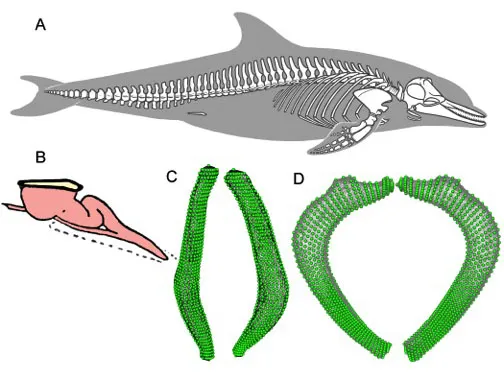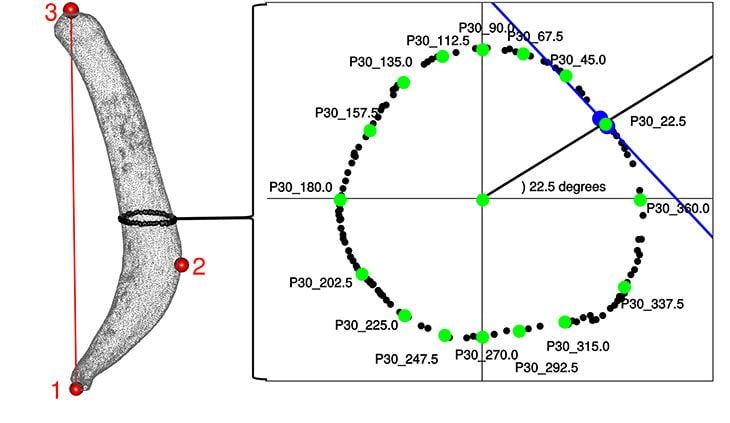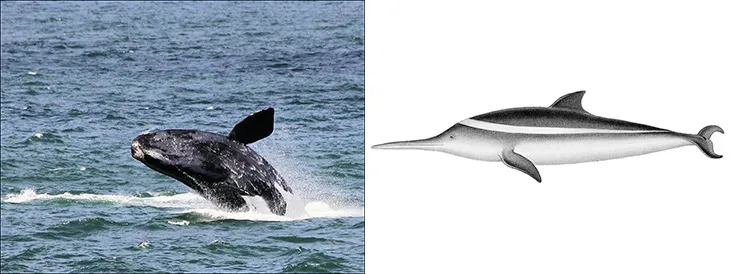Promiscuous Whales Make Good Use of Their Pelvises
Hips don’t lie: Whale pelvic bones are not vestigial but instead evolved to help the marine mammals maneuver better during sex
/https://tf-cmsv2-smithsonianmag-media.s3.amazonaws.com/filer/58/f2/58f2ecc7-e98d-41dc-9b2d-25faf99842be/01__gr45136edit.jpg)
Whales have especially small pelvic bones compared to their body size. A blue whale, for example, can grow up to 100 feet in length, about the size of a bus, but its pelvic bone is only around a foot long. For a long time scientists figured that the bones are so small because they are vestigial, a shrunken evolutionary remnant from an ancestor that once walked on land.
But now scientists have discovered that the tiny bones may actually play a huge role in whale reproduction. Whales belong to a group of sea-dwelling mammals called cetaceans, which also includes dolphins. Comparing hundreds of whale and dolphin pelvic bones to their genitalia and mating style, researchers found that males from more promiscuous species had larger penises and larger pelvic bones. A larger bone would theoretically give a whale more maneuverability while tackling the logistically difficult task of mating in the water, the team writes in a study accepted for publication in the journal Evolution.
“Contrary to popular belief, these are not vestigial structures. They do have a function. That function is reproduction, and they evolved in response to sexual selection,” says Jim Dines, a co-author on the paper and collections manager at the Los Angeles County Natural History Museum.
Humans and other land-dwelling mammals need large pelvic bones to anchor their hind legs and walk around. The bones are therefore connected to the base of the spine and the tops of the leg bones. In whales, the pelvic bones aren’t attached to anything in the skeleton—they’re just embedded in muscle. That led most researchers to assume that the isolated bones served no evolutionary purpose.
“Just because we can’t conceive of a function doesn’t mean it has no use. That’s a little short-sighted on the part of our imagination,” points out Nick Pyenson, a paleobiologist at the Smithsonian’s National Museum of Natural History in Washington, D.C. who was not affiliated with the study.
Dines and his team set out in search of a better answer. Cetacean pelvic bones attach to a muscle group called the ischiocavernosus muscles, which in most mammals also attach to genitals. Studies in rodents have shown that if you clip these muscles, a male will lose control of his penis. There’s also a lot of pelvic bone variation among cetacean species, and that piqued the team's interest. “There were so many differences between even closely related species, it was clear something really cool was going on,” Dines says.

Drawing heavily from the museum collections in L.A. and the Smithsonian in D.C., Dines tracked down pelvic bones from 130 cetaceans across 29 species. He estimates that roughly 90 percent of the specimens came from beached cetaceans and bycatch—whales and dolphins that got stuck in fishing nets.
Simply measuring the bones wouldn’t reveal enough of the intricate differences, though. “You could put [the bone] on a ruler, but these bones are curvy and weirdly shaped. So we would lose massive amounts of information if we did that,” says study co-author Matt Dean, an evolutionary biologist at the University of Southern California in Los Angeles. Instead the scientists used a laser scanner to create three-dimensional models of all the bones and then statistically measure their differences.

Mating style is obviously harder to put a number on. Studies have shown that males with larger testes come from species that mate with more partners. The more females they mate with, the more sperm they need. Thanks to records from researchers and the whaling industry, a lot of data on whale testes size, penis size and body size was available across different species, some of it dating back to the 1920s.
Comparing all of this data, the researchers spotted some trends, including the link between promiscuity (based on testes size) and pelvic bone size. To make sure this wasn’t a false positive, they performed the same laser scanning and analysis on rib bones—which unsurprisingly showed no correlation with testes or penis size. And looking at the cetacean family tree, when species diverged and became more promiscuous, the shape of their pelvic bones changed accordingly.
To feel the effects of sexual selection, cetaceans with larger or more uniquely shaped pelvic bones had to have a clear advantage in the wild. “Male cetaceans are very dexterous with their penises. I guess they have to be, because they’re mating in water,” says Dean. More promiscuous species also had longer penises, relative to their body size. The larger the penis, the larger the connecting muscle and thus, the larger the pelvic bone needed to control it.
At one end of the spectrum there’s the franciscana (Pontoporia blainvillei), a river dolphin that’s monogamous. It has the smallest testes and the smallest pelvic bone among the cetaceans they examined. The most promiscuous species, the right whale (Eubalaena glacialis), has the largest pelvic bones and the largest testes, weighing in at around a ton put together. “During breeding season, male right whales are swimming around with the equivalent of a Volkswagen bug inside of their body,” says Dean.

Both genetic studies and rare observations in the field suggest that female right whales mate with multiple males, sometimes at the same time. In a situation like that, it’s easy to imagine how greater dexterity would come in handy.
"Lots of different kinds of selection are likely operating on all organisms at all times, and so this is great to know that there are clear signals of sexual selection in the pelvic anatomy of all whales,” says Pyenson.
The researchers found a similar trend in females, which also had larger pelvic bones in more promiscuous species. Dean hazards two possible explanations: it could be a carry-over from sexual selection in males, or something could be going on with female genitalia, which are controlled by the same muscles. “A clitoris and a penis are the same thing,” says Dean. “It could be that these females are moving their clitorises around in weird ways that we don’t understand to possibly sample males while they’re mating. Who knows what they’re doing.”
Testing any of this in the field is near impossible—for now, there’s no way to x-ray whales having sex underwater to reveal the inner workings of their anatomy. All the researchers can do at this point is speculate. In the meantime, the techniques employed in the study have implications for how to study whale specimens going forward. Using the same laser scanning techniques, scientists could create digital copies for analysis or even 3D print a whale pelvic bone.
“To me it’s a more expedient way of making specimens like this that might be really rare or valuable accessible to other researchers across the world,” says Dines.
/https://tf-cmsv2-smithsonianmag-media.s3.amazonaws.com/accounts/headshot/Screen_Shot_2014-01-27_at_12.05.16_PM.png)
/https://tf-cmsv2-smithsonianmag-media.s3.amazonaws.com/accounts/headshot/Screen_Shot_2014-01-27_at_12.05.16_PM.png)